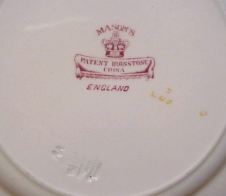Posted By: Mark
Posted on: 2013-10-23 03:13:37
Featured Item: A Worcester Pickle Dish
A Starting Point In English Ceramics
Over the years, one of the frequent questions we have heard from the public has been “What is your oldest piece?” At times it has been tossed out as an alternative to the “How’s business” salutation--just something to say. However once in a while it has represented a sincere inquiry for a starting point in understanding the 18th, 19th and early 20th century china Seekers offers. If the later is the case, the question is well put.
Currently two pieces compete for the title of “oldest piece” – an eighteenth century molded salt glaze pickle or relish dish and an eighteenth century Dr. Wall Worcester scallop shell pickle or relish dish. Both play specific roles in the story of English ceramics; ironically, both stem from the same impulse-- the eighteenth century obsession with porcelain. This article will focus on the Worcester example.
(To access product listing, simply click on any photo.)
Worcester Soft Paste Porcelain Scallop Shell Pickle Dish
Dr. Wall Period
“Two Peony Rock Bird’ Pattern
Dimensions: Width 4 ¼ in., Height 3 5/8 in.
Dates: 1755-1760
Marks: Painter’s Mark
Price: $1250.00
A Scallop Shell Pickle Dish
In the eighteenth century, a variety of small dishes were used to serve the pickles and sweetmeats which accompanied both the main and dessert courses. Remember in the eighteenth century, prior to refrigeration, both pickles and pickled sauces accompanied main food courses as agents to disguise or cover up fare gone stale or “slightly off “ ( a British tradition we discovered during one frenzied day of sightseeing at the automat lunchroom of either Syon House or Osterly Park outside London . Who needs fresh food when the houses are so dazzling?). In their work on salt-glazed stoneware, Suzanne Hood and Janine Skerry describe the role of these dishes for the dessert course on the American table. The ceramic dishes were used for the fruits and nuts, fresh, candied or otherwise preserved which accompanied glasses of jellies and heavy creams. (1)
From the earliest years of production, these relish dishes took two shapes: a scallop shell and a vine leaf. John Sandon notes that the English vine leaves generally date as early as the 1740’s and were probably German in origin. Sandon also notes that the use of the vine leaf may be related to the use of dried grapes and actual leaves in various pickling recipes. (2)
The scallop shell shape likely has more to do with function. Originally, pickle relish, with its combination of rare and exotic spices, was served on actual scallop shells, which were unaffected by the acidic properties developed in pickling. As the trade in oriental porcelain matured and European forms were sent to China for execution, the scallop shell shape was reproduced in porcelain. In turn, once an English porcelain formula was developed, the oriental shapes were produced by some of the earliest English potters.
As we pointed out in our earlier piece on Worcester and the “Blind Earl” pattern, the first patent for English porcelain was issued in 1742 with the first commercially viable production at Chelsea in 1745. Over the next decade or so, at least thirteen potting concerns sprang up, all based on the new material and technology. In 1751, the Worcester Tonquin Manufactory was born, changing its name to the Worcester Porcelain Manufactory by 1752. According to tradition, Dr. John Wall and William Davis created the first Worcester porcelain in a cauldron simmering in the fireplace of Davis’ apothecary office. Sandon, however, speculates that the Worcester product may have earlier origins, the important link being Benjamin Lund.
Benjamin Lund was a partner in the short-lived London Limehouse works between 1745 or ‘46 and 1748. When those works failed, Lund, having secured the lease on an important deposit of soap rock near Bristol, continued development of his porcelain body using soap rock and became a major partner in works at Bristol. In 1752, as that enterprise faced bankruptcy, the Worcester partners absorbed the entire Bristol concern, bringing Lund with his considerable expertise to Worcester. Sandon speculates that it was the formula Lund developed at Bristol, his expertise, and of course his access to soaprock which became the primary factors in the earliest Worcester porcelain.
Sandon’s theory is supported by examples of this particular scallop shape among pieces attributed to the Limehouse works. The shape appears again among wares from Bristol, and, as this piece attests, continues at Worcester.
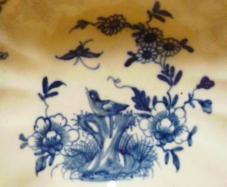 The “Two Peony Rock Bird’ Pattern
The “Two Peony Rock Bird’ Pattern
In addition to the technology involved in producing a porcelain body, decoration plays a key role here.
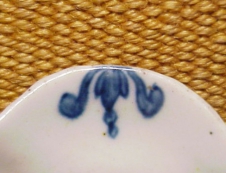 The “Two Peony Rock Bird” pattern is a blue underglaze painted pattern. The earliest surface decoration was executed in enamels on top of the glaze – leaving the decoration particularly susceptible to, among other threats, pickling acids. The more stable painted underglaze blue decoration followed a bit later, delayed by the difficulties of controlling the pigments during the glaze firing. The third method of decoration, underglaze blue transfer printing would not be adopted at Worcester until around 1759 or 1760.(3) For this reason, collectors place a premium on the underglaze blue painted patterns.
The “Two Peony Rock Bird” pattern is a blue underglaze painted pattern. The earliest surface decoration was executed in enamels on top of the glaze – leaving the decoration particularly susceptible to, among other threats, pickling acids. The more stable painted underglaze blue decoration followed a bit later, delayed by the difficulties of controlling the pigments during the glaze firing. The third method of decoration, underglaze blue transfer printing would not be adopted at Worcester until around 1759 or 1760.(3) For this reason, collectors place a premium on the underglaze blue painted patterns.
Today we think of dinnerware in terms of patterns and complete sets identified by trendy and romantic names. The eighteenth century consumer, however, thought of dinner, dessert, and tea services separately and saw no reason why they should match each other. At Worcester, specific patterns were loosely assigned to specific wares based on use. Worcester used the “Pine-cone” pattern for flat diner wares to enable dealers to make up complete services in one pattern. Teawares were dominated by the “Mansfield” and “Three Flowers” patterns . (4)The “Two Peony Rock Bird” pattern was used only on Worcester’s scallop shape pickle dish. While Worcester produced these pickle dishes with overglaze enamel decoration, and even a small number with other blue painted underglaze patterns, the bulk of these pieces seem to have been in the blue underglaze painted “Two Peony Rock Bird” pattern. (5)
" Pine-Cone" Salad Bowl and "Three Flowers" Sugar Bowl
And as for those names – “Pine-Cone,” “Mansfield,” “Three Flowers,” “Two Peony Rock Bird,” and the rest – they are sobriquets acquired over one hundred plus years of study, collecting, and classification. One can hardly imagine a supervisor at Worcester instructing a decorator to turn out more “Two Peony Rock Bird” pieces.
In the early years of the English ceramics industry, identifying factory marks were -- to the chagrin of later collectors – sporadic at best. John Sandon notes that the first Worcester factory mark, the crescent mark was introduced c. 1758. (6) We do, however, have some record of Worcester workmen’s marks used prior to the introduction of factory marks. This piece bears one of those workmen’s marks –confirming manufacture at Worcester between 1753 and 1760.(7)
Sandon provides even more specific information. In his catalog to the Zorensky Collection, he notes that production of the blue painted scallop shell dishes commenced around 1755, ending for Worcester in 1760. (Variations of the shape continued at other potteries). By contrast, Sandon notes that the leaf shape, seemingly uncommon before 1760, became popular at Worcester between 1765 to 1775.(7)
So what makes this piece special?
As you may recall from our piece on Worcester’s “Blind Earl” pattern, the very idea of porcelain reached Europe in an almost casual reference in Marco Polo’s account of his adventures in Cathay around 1300. For the next two hundred years, the scarce imported ware was one of the treasured currencies of diplomats and the nobility, with commercial trade only commencing around 1500. Viable European-made porcelain did not appear until 1710 – at Meissen, and the English were even later with their first patent in 1742. This piece dates 1755-1760 – at most only fifty years after the first European porcelain appeared!
For me there is one aspect which I find totally thrilling, what I call the notion of “first generation” wares. Whether it is a piece of Wedgwood basalt made in Josiah’s lifetime, a piece of Rookwood pottery made in the experimental first two decades of that American institution, or an example of Robertson’s efforts at Chelsea Keramic in Massachusetts, ceramics that connect to specific founding personalities possess a special fascination for me. In Worcester, that “first generation” is known as the Dr. Wall period.
The Dr. Wall period dates from the establishment of the works in 1751 to the 1770’s (8). The “Dr. Wall” designation signifies that this piece dates from those first exciting years at Worcester. It is no stretch of the imagination to consider that as this piece was being taken from the kiln, the man whose name is synonymous with the earliest Worcester porcelain was walking those very premises.
It can’t get much better from here, but it does. Here the piece speaks for itself -- a scallop shell pickle dish in soft paste porcelain. In body and form this piece connects with Benjamin Lund and to an expertise extending back to the earliest English porcelain at Limehouse. The men who modeled and fired this piece likely had worked with Lund; the hand that painted that pattern had seen “Mr. Lund”; and when you hold this piece in your hand you are only a few hands away from the Englishmen who made this one of the most exciting periods in the story of English china.
That is why this piece, one of the two “the oldest pieces in Seekers inventory,” is possibly the best starting point we can offer in the study of English ceramics.
Later, Mark
(1) Skerry, Janine E. and Hood, Suzanne Findlen. Salt-Glazed Stoneware In Early America. The Colonial Williamsburg Foundation, Williamsburg, Virginia, 2009. p. 148
(2) Sandon, John. The Dictionary of Worcester Porcelain, Volume I, 1751-1851. The Antique Collectors’ Club Ltd., Woodbridge, Suffolk, England, 1993. p. 259
(3) Young, Hillary. English Porcelain, 1745-1795, Its Makers, Design, Marketing and Consumption. V&A Publications, London, 1999. p. 64
(4) Sandon, John. Op Cit, Dictionary, Pattern Entries, p. 228, 261,336
(5) Spiro, Simon & Sandon, John. Worcester Porcelain, 1751-1790, The Zorensky Collection. Antique Collectors’ Club, Woodbridge, Suffolk, England, 1996. No. 535, p. 407, No. 537, p. 408.
(6) Spiro, Simon & Sandon, John. Ibid, p. 509
(7) Spiro, Simon & Sandon, John. Ibid, p. 509
(8) Spiro, Simon & Sandon, John. Ibid, No. 535, p. 407, No. 537, p. 408
(9) Sandon, John. Op Cit, Dictionary, p. 122. There is some discussion of the exact dates of the Wall period. Should the period terminate with the sale of the factory in 1772, the retirement of Dr. Wall in 1774, or 1776 when Dr. Wall died? At any rate, the Dr. Wall period ends in the 1770’s.
References Not Noted Above
Godden, Geoffrey A., F.R.S.A. Godden’s Guide to English Blue and White Porcelain. Antique Collectors’ Club, Woodbridge, Suffolk, England, 2004
Sandon, Henry. The Illustrated Guide To Worcester Porcelain. Praeger Publishers, New York, 1970
Sandon, John. Phillips Auctioneers And Valuers. The Watney Collection of Fine English Porcelain, Part I, 11 AM Wednesday 22nd September 1999, 101 New Bond Street, London. Phillips Son and Neale Limited, 1999
Spiro, Simon. Worcester Porcelain, The Klepser Collection. The Minneapolis Museum of Art, Lund Humphries Publishers, London, 1984
Posted By: Mark
Posted on: 2013-05-01 07:21:39
The "Double Landscape Pattern": Masons By Any Other Name . .
Identifying nineteenth century ceramics can be confusing, frustrating, and even intimidating. These reactions are the result of a constant flux in the young ceramics industry. Changes of ownership, partnerships and even names were the rule rather than the exception. Along with these changes, patterns and even maker’s marks often changed hands without notice by the public (or by many collectors today). Compounding this sense of bewilderment, while pieces -- especially transfer ware -- could be marked more easily than ever, such marking was often inconsistent or even non-existent. To be fair, however, we have to admit that modern scholars often bring twentieth century consumer expectations to the table. Coming from an era when manufacturers guard brand identity, prominently label, and foster continuity in their products, it is no wonder we become easily disoriented.
In this article, we look at four examples of the Masons Ironstone “Double Landscape” pattern -- all marked differently -- and the chapters of the Masons story they reflect.
.jpg)
Jug, Crown & Drapery Mark Jugs, Fenton Stone Works Marks
Dates: 1830's Dates: 1830-1840's
Dimensons: Height 6 1/2 in. Dimensions: 9 1/4 in., 8 1/2 in.
Price: $795.00 Price: $1250.00, $1050.00
Soup Plate, Ashworth Mark Charger & Luncheon Plates (12)
Dates: Date Mark for 1884 Dates: 1891-1910; Some Date Marks for 1901
Dimensions: 10 3/8 in. D. Dimensions; Charger, 12 1/21 in. D. Plates, 9 ¼ in. D.
Price: $225.00 Price: Charger $375.00 Plates, $155.00 ea.
(We urge you to click on any of the photos for additional images and full descriptions.)
Masons Ironstone -- Origins
The pieces we are considering all follow the 1813 patent which established Masons Patent Ironstone China. However a brief introduction to Miles Mason, founder of the dynasty is important to the Masons story. Miles Mason came to the business through his father-in-law, Richard Farrar. Farrar was a prominent glass seller and chinaman serving the carriage trade of eighteenth century London. The china offered in Farrar’s establishment was porcelain imported from the exotic East. Exposure to this retail point of view gave Miles Mason the experience of dealing with the British public and insights into their enduring fascination with all things oriental. This initial exposure to the trade also provided Mason with the philosophy which would mark his efforts as he moved from retailer to manufacturer. Gay Blake Roberts summed up this philosophy; “to make relatively inexpensive, useful wares that could be brightly decorated with cheerful patterns or simply decorated in underglaze blue.” (1)
The “Double Landscape” Pattern
The “Double Landscape” pattern (like almost all Masons Ironstone) is a transfer-printed ware richly enhanced with enamel highlighting. According to Roberts, Masons introduced their “Double Landscape” pattern around 1830. Failing in a search for more specific information, we turned to a friend with some expertise in oriental porcelains. His quick appraisal was that this pattern was best described as a pastiche of a number of Imari patterns -- an observation applicable to a large portion of the Masons production.
The Crown and Drapery Marks
The jug shown here, by no means a common shape among Masons jugs in general, is the form most often associated with the “Double Landscape” pattern. Early examples of the pattern feature a traditional Imari palette dominated by a cobalt ground with contrasting scarlet panels. The Crown and Drapery mark it bears was used widely and is almost synonymous with Masons.
The 1813 patent for ironstone china was a defining event in the history of Masons Ironstone China. Prior to this, under Miles Mason’s leadership, a variety of wares had been produced including porcelain, earthenware and the prototypes which led to the patent. Coincidently, in the same year that Masons received the patent, Miles Mason retired from the business, establishing all three of his sons in the potting business. The eldest, William had been set up in a pottery of his own, while the other two, George Miles and Charles James, were made partners in the already successful family pottery.
While Charles was named patentee for the ironstone body in 1813, the concept of a durable body, with a hardness between earthenware and porcelain, had been around since at least 1800 when John and William Turner secured the first patent for this type of ware (and marked their product “Turner’s Patent.”) By the time the Mason’s secured their patent various potters were making their own versions, including Spode, Davenport, and others -- some now forgotten.
Sources generally agree that the earliest Masons Ironstone marks are impressed: either circular or straight line marks (executed in one or two lines). These marks read “Patent Ironstone China” or “Masons Patent Ironstone China” and were used until about 1830. The common assumption is that printed marks were phased in during the eighteen twenties. However Geoffrey Godden has quoted an 1815 announcement in which the Masons defended a challenge to their patent rights, declaring that “all china purporting to be ironstone is spurious and a mere imitation which is not printed at the back Patent Ironstone China under a crown.” [Our italics] (3)
Anyone familiar with much of the Masons production will detect Charles’ bluster. Marking was simply not that consistent. The printed crown and drapery mark is absent from most impressed marked examples and a sizable portion of the wares bear no mark at all. Nevertheless, from the Masons response to the little inter-industry squabble, we know that the Crown and Drapery mark was employed in some form as early as 1815.
As important as the 1813 patent itself was the brilliant marketing use the Masons made of their patent, especially in regard to the crown and banner mark. The wording of the mark staked a claim on the public’s consciousness almost impossible to challenge: “Masons” -- denoting ownership, “Patent” -- something new and unique, “Ironstone” -- durable to the point of eternal, “China” -- of the same status as the revered porcelain wares from the orient. (4) This mark and its variations became, in twentieth century terms, Mason’s brand.
One last note regarding the crown and drapery mark found on our featured jug (above); scholars agree that the more severely angled crown indicates an 1840’s production date.
The Fenton Stone Works Marks
In all our years of business these two jugs are the first “Double Landscape’s” we have encountered in this high-shouldered, narrow footed, extroverted shape. The scalloped edge and the overall flamboyance speak to the early Victorian taste for the rococo style. More central to our discussion, they bear what is certainly the most misunderstood of the Masons logos: the Fenton Stone Works mark.
Too seldom do enthusiasts of Staffordshire wares realize that pottery production sites frequently bore a name distinct from that of the owners or operators. Almost immediately upon being made partners in their business, George Miles and Charles James Mason, with their elder brother William secured a larger facility. The name of that facility was the Fenton Stone Works.
The acquisition of the Fenton Stone Works represents a significant expansion of the family’s business. However in 1813, the action also represented a breath taking risk. The British economy was in a dire position affecting all trades. Britain was at war with one of her major trading partners, the United States, as well as France and her allies Reports circulated of London retailers unable to cover their bills, and there was a prevailing sense that tablewares simply were not selling. The Staffordshire potters even banded together to appeal to the Prince Regent on working conditions and to petition parliament to undertake measures to bring about peace.(5)
In such an economic climate – and with a new patent for a ceramic body of untried potential – one might have expected a greater sense of caution. With faith in the future, however, the brothers banded together to purchase the bigger pottery which they occupied two years later in 1815 (when the lease of the current occupant, Spode, expired).
.jpg)
The Masons’ pride in their modern factory was eloquently expressed on their new trade cards and bill heads which pictured the stone works’ front elevation. That pride was justified, according to Simeon Shaw, who waxes poetic in his admiration of the operation in his 1829 History of the Staffordshire Potteries:
“The manufactory of Mesrs. G&C Mason, for Patent Iron-Stone China, is commodious. Here is a Steam Engine of some peculiarity in its construction, by Holford, of Hanley… with a cylinder only the size of a six-horse power engine, this has always done the work of others rated as equal to sixteen horses. The front of the Warehouse is four stories high, is fire proof, and has the most beautiful façade of any in the district.” (6)
Whether based on wise forethought or the untested optimism of youth, the gamble paid off. The Fenton Stone Works proved capable of accommodating the growth of Masons Patent Ironstone China almost through the final bankruptcy in 1853.
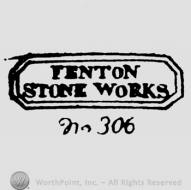
_f196x191_1367439525.jpg)
The Fenton Stone Works mark is found in two forms, the framed format used on these jugs and a second more elaborate mark topped with an impressive block long, four story structure similar to the image on their trade cards and stationery.
Scholars seem to be uncertain of the duration of the Fenton Stone Works marks. Both Geoffrey Godden and Gay Blake Edwards agree on an 1825 introduction of the mark. Edwards goes on to note an 1840 cutoff, while Godden avoids giving an end date. Greater uncertainty exists over the status of the mark since it was used simultaneously with the crown and banner. Many including Godden assume that it was assigned to more mundane, utilitarian wares. However the jugs at hand and other examples we have known would challenge that prejudice. As with the use of printed marks in the 1810’s (discussed above) we simply do not believe that the Masons – or many of their Staffordshire colleagues – were that consistent in their marking practices. In our experience, Fenton Stone Works pieces often deserve no less respect than that accorded pieces marked “Masons Patent Ironstone China.”
Ashworth and the “Double Landscape” Pattern
This 1884 soup plate represents “Double Landscape” updated for the tastes of a new generation. Gone in this particular example are the contrasting primary blue and red colors derived from the Imari sources. Instead the deep green ground color creates a more subdued harmony. Enamels are applied in a less vigorous manner. Tellingly, the rococo inspired ribs and scallops have been replaced with a simple, more pure silhouette. The direct influence of the East has been tempered by the reinterpretation of Japanese goods popular in European markets at the end of the century.
Note the marks. Our familiar crown and drapery trademark has been replaced with a new version: the crown and ribbon. The name Mason is nowhere to be seen. The mark is inscribed “A. Bros.” Barely legible impressed marks reveal that the “A” stands for Ashworth“ – “Ashworth Real Ironstone China.”
This new version of Masons “Double Landscape” must have created a sense of excitement in the marketplace of the sixties, seventies and eighties, however it gave no hint of the changes which had transpired back at the pottery.
Charles James Mason died in 1856. From 1848 to 1853 the effort to keep Masons Patent Ironstone viable had been a struggle. A strategy of selling directly to the public through open auctions had alienated retailers and flooded the marketplace, devaluing the goods. The long-term results were disastrous. Complicating matters, the Masons workplace became increasingly polarized by the (often opposing) forces of new technology and worker’s rights. Initially hailed as an advocate of the workingman, Charles James Mason failed to keep abreast of changing times, finally allowing his life to be defined in the contentious terms of labor vs. management.(7)
As Mason faced bankruptcy in 1848, another Staffordshire potter named Francis Morley swept in at the eleventh hour securing a large share of the Masons property, ranging from molds and printing plates to the rights to Masons trademarks. Bankruptcy was forestalled, but it only prolonged Charles James Mason’s predicament until 1853 when it became final.
However, Masons Patent Ironstone China did not die. Morley continued producing Masons traditional wares in his own factory, using the 1840’s angled crown and drapery mark with the addition of “Morley” beneath—yet another moniker under which Masons patterns appear. Around 1858, Morley took George L. Ashworth into partnership and retired shortly after. In August 1860 the operation assumed the new name George L. Ashworth & Brothers.
In his 1878 volume, The Ceramic Art of Great Britain, noted historian Llewellyn Jewitt included a description of the Ashworth marks. He also took the opportunity (like Simeon Shaw around fifty years before) to praise the Masons, Francis Morley and the Ashworths for maintaining the best examples of the manufacture of ironstone wares -- principally those products that originated under the ownership of Mason. (8)
Eventually, in something like a marketing sleight of hand, the Ashworth’s resurrected a reverence for the forgotten Mason product --- which the public had rejected a short time earlier. In effect, the Ashworths created new awareness of the Masons Ironstone heritage, promoting themselves as the only legitimate trustees. While the Ashworths continued to produce a wide range of ceramics, the crown and banner mark reappeared on patterns originally produced by Masons or in a similar style. The quality of these wares is variable. Often pieces we have encountered have exhibited the dense ironstone body associated with Masons -- as in this example. However, the Ashworths were businessmen, at times trading on the Masons name with lighter weight common earthenware. Still, under the Ashworths’ stewardship, the Masons brand was on the stable trajectory which would carry it well into the twentieth century.
The Crown and Banner Mark and the Twentieth Century
These luncheon plates and charger represent Masons Ironstone in the twentieth century -- but just barely. An impressed year mark on some of the plates documents a 1901 production date.
More significant is the appearance of the printed crown and banner mark and the prominence given to the name Masons. While accompanying impressed marks continue the designation “Ashworth Real Ironstone China,” these printed marks provide insight into the Ashworths’ vision for their revived Masons brand at the start of the new century. There is one more addition to the marks. “England” is noted as the country of origin in compliance with the United States’ McKinley Tariff Act of 1890.
These pieces also demonstrate some shift in design, possibly to appeal to the emerging taste for Georgian/Colonial Revival design in England and the U.S. The slightly contoured and scalloped shapes of these pieces indicate a return to pre-Ashworth period Masons shapes. Once again we see the traditional blue and red Imari palette here -- actually it never completely disappeared -- though Ashworth’s colors create a more subdued contrast. As with our 1880’s soup plate, the tracery patterns are executed in gilt rather than ochre enamel.
There was one more twist to the Masons story as the pottery approached the twentieth century, one that has largely escaped public notice then or now. The wealth of the Ashworths was based on the textile trade. In 1883, when their textile mills failed, the Ashworth’s were forced to sell the pottery. The new owners, the Goddard family would steer it through most of the twentieth century, although like many modern business proprietors the Goddards remained totally faceless. Who seeks out “Goddards Ironstone China?”
The Ashworth and Mason products continued to be produced with both Ashworth and Masons marks as demonstrated by the pieces at hand. However, while maintaining the carefully cultivated heritage of Masons Ironstone China, the Goddard’s expanded the offerings in an effort to keep the Masons brand relevant to the times.
Conclusion: Masons Ironstone and the “Double Landscape” pattern
In 1968, the Ashworth firm, under the direction of the Goddard family, changed its name to ‘Masons Ironstone China Ltd. ‘ In 1973 it became a part of the Wedgwood group, a move marked by yet another name change: this time to simply ‘Masons Ironstone’.
In the late 1990’s, Gay Blake Roberts, curator of the Wedgwood museum, compiled her account of the Masons story, Mason’s The First Two Hundred Years, the old “Double Landscape” pattern still had some life left in it. She includes an example of the pattern dating from the early 1990’s.(9). The mark she notes for the latest production is the most recent variation on the crown and drapery mark; an angled crown with "Masons" overhead and drapery inscribed "Patent Ironstone, Made In England."
So in closing, we return to the enduring crown and banner mark and Mason name --not Morley, not Ashworth and certainly not Goddard . Still Masons Ironstone, if by any other name.
Cheers, Mark
Image Credits:
Fenton Stone Works Trade Card: Google Images; 2005 Copyright held by Keele University, Staffordshire
Fenton Stone Works Trademarks: Marks &Library by Worthpoint; http://www.marksandlibrary.com/marks/ceramics/mark-138853_fenton-stone-works-306
All other images, Seekers Antiques
Footnotes:
(1) Roberts, Gay Blake, Curator, The Wedgwood Museum; Mason's, The First Two Hundred Years ; Merrell Holberton Publishers Ltd.; London; p. 18
(2) Ibid, Roberts; p. 123
(3) Godden, Geoffrey, F.R.S.A.; Godden's Guide to Ironstone, Stone & Granite Wares; Antique Collectors' Club Ltd., Woodgridge, Suffolk, England; 1999; pp. 77, 99
(4) Roberts, Op cit; p.23
(5) Godden, Op cit; pp. 79,80
(6) Shaw, Simeon; History Of The Staffordshire Potteries, Originally Published in 1829; Praeger Publishers, New York, Washington; 1970; p. 70
(7) Roberts, Op cit; pp. 24,26
(8) Jewitt, Llewellynn; The Ceramic Art Of Great Britain; New Orchard Editions Ltd.; Poole, Dorset, England; 1985; pp 491,492
(9) Roberts, Op cit; p. 123
« Prev
Next »









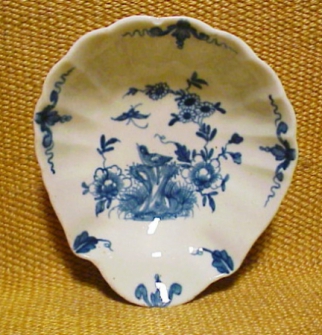
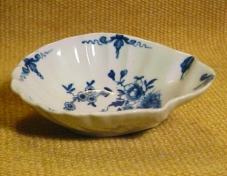
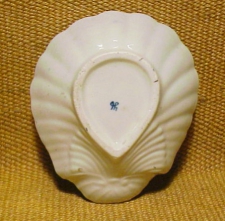
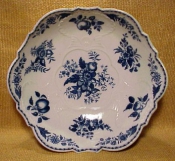
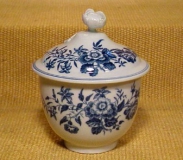
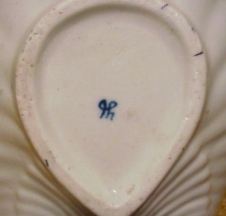
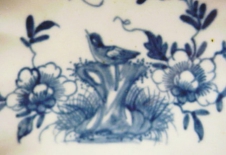
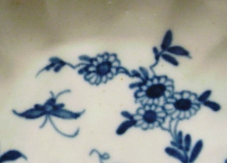
_f226x208_1367418665.jpg)
_f271x210_1367418692.jpg)
_f225x212_1367418748.jpg)

_f224x208_1367418940.jpg)
_f227x208_1367418967.jpg)
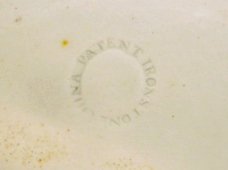
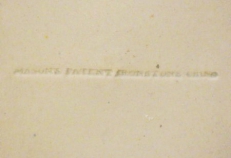
_f226x170_1367419145.jpg)
_f224x190_1367419188.jpg)
_f313x217_1367438742.jpg)
_f230x171_1367438954.jpg)
_f219x203_1367419337.jpg)
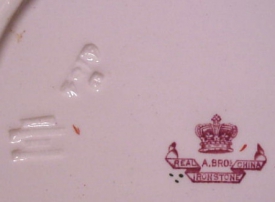
_f247x197_1367419703.jpg)
